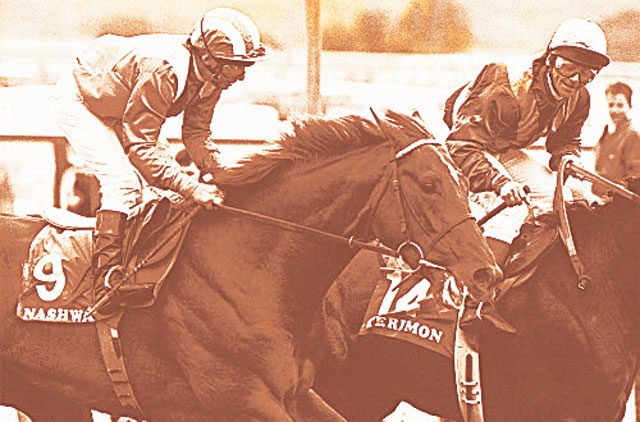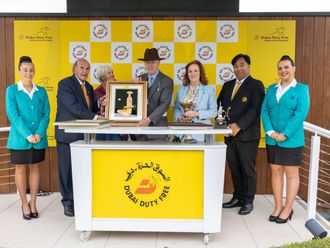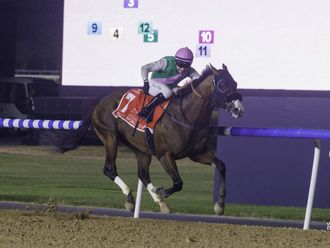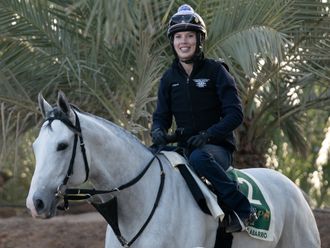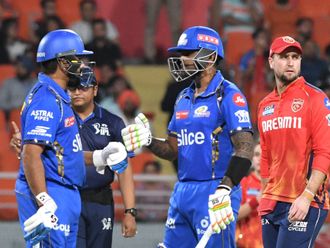
Dubai: Ever wondered why names were given to race horses like Secretariat, Seabiscuit, Brigadier Gerard, Man O' War or Nijinsky? What was the connection between a legendary ballet dancer and the colt that won the English triple crown — the 2,000 Guineas, Derby and St. Leger — in 1970?
Like Vaslav Nijinski, the most famous male dancer of the 20th century, Irish trainer Vincent O'Brien's colt became one of the greatest horses in thoroughbred racing history.
It appears that choosing a name for a horse can be a very profound and passionate process. It certainly is in the case of Shaikh Hamdan Bin Rashid Al Maktoum, Deputy Ruler of Dubai and Minister of Finance, one of the most successful owners and breeders on the international racing scene over the last 30 years.
Shaikh Hamdan has bred and owned some great champions, all of whom he has given characteristically Arabic names like Al Bahathri, Nashwan and Salsabil. But what's the story behind the names? Why name a horse ‘River in Paradise' (Salsabil), ‘Overjoyed' (Nashwan) or ‘Lavendar' (Al Bahathri)?
Mirza Al Sayegh, who for the past three decades has assumed many roles for Shaikh Hamdan, including director of his office, personal adviser and president of Shadwell Farm, knows the inside story, having been actively involved in the complex naming process.
"The Arabic naming process has been adopted for several reasons," he says. "Number one because Shaikh Hamdan wants to preserve the Arabic language and number two because the names are unique and easy to remember. Number three, some of the Arabic words are very close to the breeding of the horse.
"So that's why you see all the progeny of Nashwan have been given very nice Arabic names. I agree that some of the words may not be easily pronounced by English-speaking people, but with the habitual repetition of calling the name it is very easy to get used to it.
"In my opinion Shaikh Hamdan is very wise in doing that because, when you see the names in Arabic, you will immediately identify with the owner. So when you see the list of the names without any colours you will know that this is one of Shaikh Hamdan's horses.
"The late Shaikh Maktoum used Arabic names as well, names like Rahy and Wafi, but he also used English names. Shaikh Hamdan does not like to use English names for his horses except for the ones that he bought, like Invasor, who was already named.
Very close to his heart
"Some of the names are very close to his heart, for example Nashwan, whose name was selected by a family member and he respected that selection and he gave it to the horse, the son of Blushing Groom, and he became famous."
Al Sayegh revealed that some horses were so important to Shaikh Hamdan, even as yearlings, that he gave them a special name.
"He chose Salsabil, which means River in Paradise, for the daughter of Blushing Groom and we all know that she went on to be as special as her name," he said.
"Nashwan, Unfuwan and Marju — they were all special names.
"Marju was originally named Al Marju, but when Shaikh Hamdan learned that the connotation also meant the name of ‘God', he decided to change the name to Marju. But the Jockey Club would not agree as the horse had already been registered and had also run.
"So Shaikh Hamdan told the Jockey Club officials that if they did not change the name he will not run the horse, but just keep it inside the box until he dies.
"Extraordinary as it was, the Jockey Club gave way to his request and allowed the change of name. The rest is history, Marju went on to become a champion of sorts."
All racehorses have to be registered at the relevant racing authorities around the world, like the American Stud Book, British Horseracing Authority or the Emirates Racing Authority's Registry Office.
Al Sayegh explained that the process of registering a horse is far from simple and involved a procedure which makes Shaikh Hamdan's task of selecting names even more difficult.
"Given the strict guidelines under which the various racing authorities operate, naming a horse can be quite complicated," he said.
"Before selecting a name for a horse, Shaikh Hamdan sometimes spends hours researching names, pedigree, history etc.
"He checks the progeny of the horse. has books of names which he uses as a reference, a dictionary if necessary, but he never selects a name from out of the air. It is a very passionate process.
Translation
"We then take those Arabic names and re-type them and do the translation because the register insists on having an English translation of the name with its meaning before they accept it and register the horse.
"What we do now is we select the name and send them to be reserved. In recent years there are more and more Arab horse owners who, like Shaikh Hamdan, want to give their horse an Arabic name, so there can sometimes be a demand for special words. So that's why you have to reserve a name.
"In those weeks Shaikh Hamdan has to sit and look at all his young horses which have to be named. Every year we need about 220 names, but for 220 names to be accepted we need at least 600 names to be sent to the Jockey Club or the British Horseracing Authority. You send 100 and they accept 50, you send another 100 and they accept 30, so it's not easy."
What was the story behind some of Shaikh Hamdan's star horses, like At Talaq, Al Baharthri, Almutawakel, Erhaab, Haafhd, Nayef, Salsabil and Sakhee?
"Shaikh Hamdan could not have chosen better names for some of these horses. They all lived up to their names," he said.
"Al Talaq, which means breeze in English, was Shaikh Hamdan's first Melbourne Cup winner. He was a very nice horse. Shaikh Hamad had a meeting with the FNC [Federal National Council] and could not attend the race, but during the meeting he got a call from Australia's Prime Minister, who was the first person to tell him that his horse had won the Melbourne Cup and congratulate him.
"Salsabil was a beautiful name for a beautiful horse. Shaikh Hamdan chose the name, which means River In Paradise, because he felt that the filly was special. And she was, right from the time she won the Group One Prix Marcel Boussac, the premier two-year-old contest for fillies in France.
Would she last the distance?
"Her Classic season began with a six-length victory in the Fred Darling Stakes at Newbury, before she went on to win the 1,000 Guineas at Newmarket and the Oaks at Epsom.
"Many felt that she would not get the trip at Epsom, but Shaikh Hamdan was confident that she would stay the Oaks distance and he was proved right — she won the race by five lengths. "After her Epsom showing, Shaikh Hamdan sent her to The Curragh to contest the Irish Derby, which she won in style to become the first filly to win the race since 1900.
"Al Bahathri was also a horse very close to Shaikh Hamdan. Her name means lavender and she became the first star name to represent Shaikh Hamdan and was the most successful horse ever trained by Tom Jones."
Al Sayegh also revealed that Shaikh Hamdan learned a lot about horses from his father, Shaikh Rashid Bin Saeed Al Maktoum, which helped him a lot in choosing names for his horses.
"Almost everything Shaikh Hamdan knows about horses today, he learned from his father, who had a unique way with horses," he said.
"We all learned a lot from Shaikh Rashid by just listening to him. It was that simple.
"Shaikh Hamdan also learned how to spot an injury on a horse from his father. Shaikh Rashid told him that there was something that they did with camels who were injured. They would pour water on the body of the camel and wherever there was an injury that area would still be wet even as the rest of the camel was dry.
"So he suggested to Shaikh Hamdan to try the same on the horses and that is true. There once was a horse that pulled a muscle and the trainer did not know what happened. So Shaikh Hamdan told the trainer to wash him and wait for ten minutes or so. So they washed him and after 15 minutes the horse's body was dry except for the spot where the injured muscle was, which was still damp.
"As soon as they touched the spot, the horse began to kick. Some trainers around the world still use that old technique, which is very good. So Shaikh Rashid had this sense with animals."


